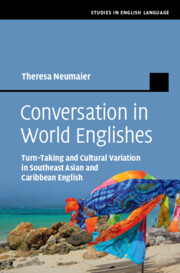 Conversation in World Englishes
Conversation in World Englishes Published online by Cambridge University Press: 30 March 2023
This chapter provides a quantitative analysis the strategy clusters Southeast Asian and Caribbean interactants use for claiming or holding a turn at talk. It can be shown that speaker groups essentially use the same strategy combinations, although some differences also become apparent. The second part of the chapter zooms in on the frequency of selected phonetic and syntactic resources and compares their usage across the two speaker groups. Again, both similarities and differences between the speaker groups become apparent; for example, with respect to the usage of tempo downsteps or direct requests. These findings support the notion of a locally inflected conversational infrastructure, which is influenced by both cultural context and variety-specific preferences.
To save this book to your Kindle, first ensure [email protected] is added to your Approved Personal Document E-mail List under your Personal Document Settings on the Manage Your Content and Devices page of your Amazon account. Then enter the ‘name’ part of your Kindle email address below. Find out more about saving to your Kindle.
Note you can select to save to either the @free.kindle.com or @kindle.com variations. ‘@free.kindle.com’ emails are free but can only be saved to your device when it is connected to wi-fi. ‘@kindle.com’ emails can be delivered even when you are not connected to wi-fi, but note that service fees apply.
Find out more about the Kindle Personal Document Service.
To save content items to your account, please confirm that you agree to abide by our usage policies. If this is the first time you use this feature, you will be asked to authorise Cambridge Core to connect with your account. Find out more about saving content to Dropbox.
To save content items to your account, please confirm that you agree to abide by our usage policies. If this is the first time you use this feature, you will be asked to authorise Cambridge Core to connect with your account. Find out more about saving content to Google Drive.